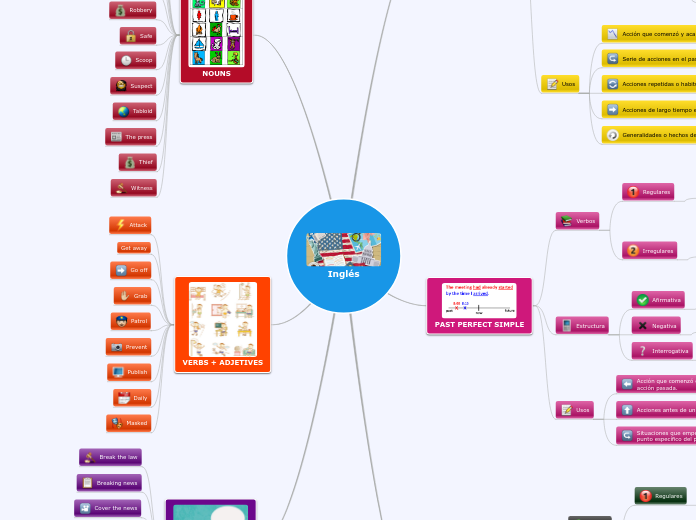Inglés
EXPRESSIONS
News source
News bulletin
Live broadcast
Hold a press conference
Front page
Cover the news
Breaking news
Break the law
VERBS + ADJETIVES
Masked
Daily
Publish
Prevent
Patrol
Grab
Go off
Get away
Attack
NOUNS
Witness
Thief
The press
Tabloid
Suspect
Scoop
Safe
Robbery
Reporter
Lock
Headline
Evidence
Burglar alarm
PRESENT PERFECT SIMPLE
Acciones en diferentes momentos en el pasado.
Acciones que todavía no han sucedido.
Éxitos o logros.
Un cambio en el tiempo.
Describir una experiencia.
Verbo auxiliar (to have) + sujeto + participio pasado…?
Has she gone to work?
Sujeto + verbo auxiliar (to have) + “not” + participio pasado…
She hasn’t gone to work.
Sujeto + verbo auxiliar (to have) + participio pasado…
She has gone to work.
Has/have + Past Participle (third column)
Has broken
Have been
Has/have + infinitivo + ed
Has visited
Have talked
PAST PERFECT SIMPLE
Situaciones que empezaron en el pasado y siguieron hasta un punto específico del pasado.
Acciones antes de un tiempo específico en el pasado.
Acción que comenzó en el pasado y que es anterior a otra acción pasada.
“Had” + sujeto + participio pasado…?
Had they studied English before they went to London?
Sujeto + “had” + “not” + participio pasado…
They hadn’t studied English before they went to London.
Sujeto + “had” + participio pasado…
They had studied English before they went to London.
“To had” + Past Participle (third column)
Had drawn
Had seen
Had + infinitivo + ed
Had worked
Had visited
PAST SIMPLE
Usos
Generalidades o hechos del pasado.
Acciones de largo tiempo en el pasado
Acciones repetidas o habituales en el pasado
Serie de acciones en el pasado.
Acción que comenzó y acabó en el pasado.
Estructura
Interrogativa
Verbo auxiliar (to do) + sujeto + verbo principal (infinitivo)…?
Did you believe him?
“To be” + sujeto…?
Was she a doctor?
Negativa
Sujeto + verbo auxiliar (to do) + “not” + verbo principal...
I didn’t buy a blue car.
Sujeto + “to be” + “not”...
The keys weren’t in the drawer.
Afirmativa
She was a doctor
Sujeto + verbo principal...
Verbos
Irregulares
Past Simple (second column)
Gave
Cost
Regulares
Infinitivo + ed
Learned
Wanted









